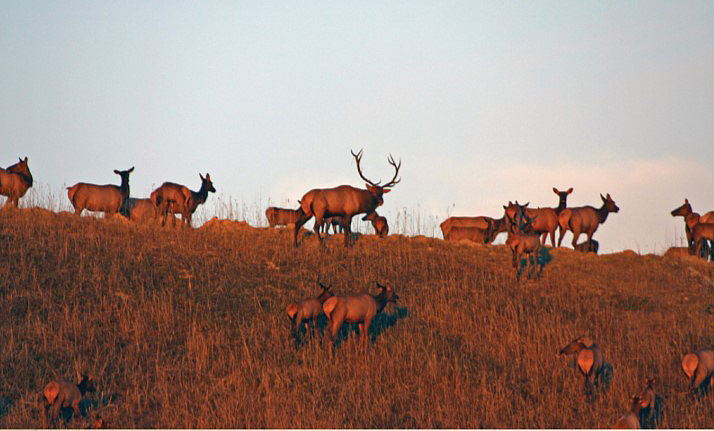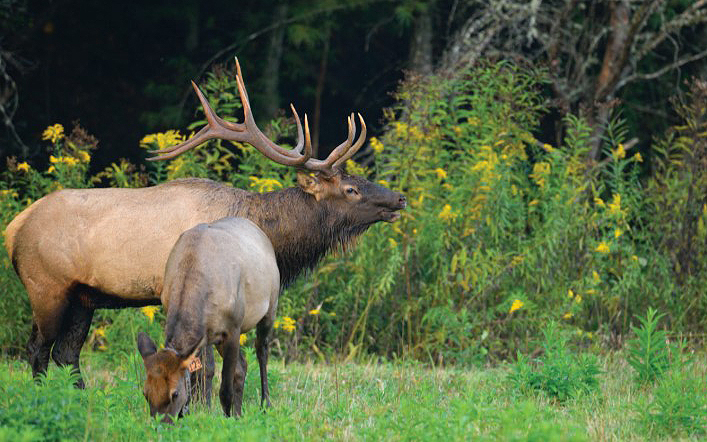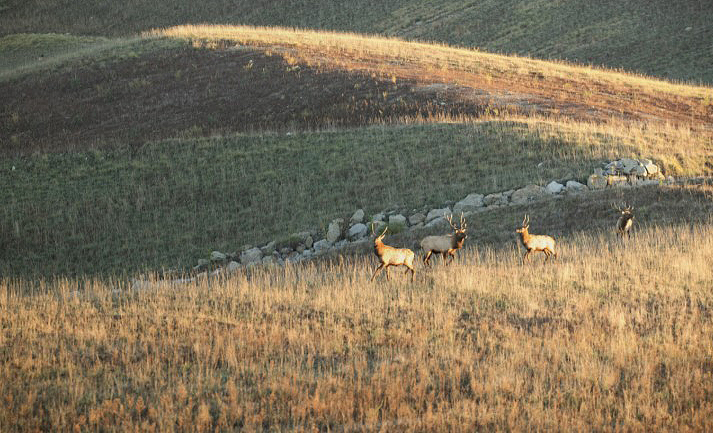Richard Hines | Originally published in GameKeepers: Farming for Wildlife Magazine. To subscribe, click here.
As settlers moved further into America from the east coast, by far the most impressive game animal they encountered was the elk. As these early explorers returned from trips over the Appalachian Mountains, they told of a land full of game, not to mention some good tales as well.
One such story was told by Charles Scott as he returned from the wilderness called ‘Kan-tuck-ee’ (Kentucky). He said, “It is a land teeming with game ready to be killed.” One of his descriptions did not quite make sense when he said, “Trees were eight to fifteen feet in diameter and they grew so close together that a man could barely squeeze between them…and the elk had horns that measured ten feet from tip to tip.” Apparently, as he was telling this story, one individual in the audience questioned how elk were able to get through the forests, of which Scott replied, “that was their business, not mine.”

Another account from the explorer Dr. Walker, described his encounter with elk during the 1750s in Kentucky when he shot an elk browsing along the bank of Rockcastle River. “Our party boned out the elk meat and cleaned the skin to repair moccasins…a week later one of our prized dogs named “Tumbler,” met his fate when a bull elk he was pursuing kicked the poor dog to death.” The area was named “Tumblers Run.”
All the eastern states have stories in their history about encountering elk, but as settlements were established, elk numbers plummeted. As an example, Kentucky’s elk would disappear from the landscape by 1850.
This extirpation of elk was not unique to Kentucky. North Carolina lost elk during the late 1700s and all eastern states began losing elk by the early 1800s. Indiana elk were gone by 1840, Illinois lost their elk in the 1850s, and the last elk was killed in Tennessee in 1865.
A few elk hung on in Pennsylvania and Wisconsin until the 1880s, but effective game regulations were still fifty years away, so unregulated hunting took its toll.
The “original elk” inhabiting most of the eastern United States were classified as “eastern elk” (Cervus elaphus canadensis), which are now considered extirpated. At the time of settlement, eastern elk were one of six subspecies present in North America. Ernest Thompson Seton estimated that one third of the 10 million elk found in pre-settlement America were eastern elk.
With the disappearance of eastern elk, little is known of the subspecies that once inhabited most the region. In fact, all eastern elk were killed before any significant number of specimens could be preserved in museums making it impossible to fully describe any morphological differences.
Today, there are differences between Rocky Mountain elk, Tule elk and Roosevelt elk which leaves little doubt there would have been some slight differences in Eastern elk.

In the 1930’s, effective deer restoration and later turkey restoration plans were taking place but efforts to restore elk predated this. Elk releases were attempted between 1893 and 1906 in New York, where 332 were released into the Adirondack Mountains. Indiana also attempted a reintroduction during the 1950s without success.
Many elk restoration efforts were also delayed, not just because of illegal hunting, but because of a parasitic nematode which carried the “Meningeal Brain Worm.” This parasitic nematode is carried by white-tailed deer and is passed through the manure where it is picked up by an intermediate host, snails. There was speculation that Eastern elk may have been resistant to brain worm, but research showed Rocky Mountain elk were not, all of which made stocking western elk a “waste of time”.
However, Kentucky’s former Big Game Coordinator, John Phillips, investigated the problem and believed that over time, reproduction would outweigh parasite elk mortality. It appears Phillips was correct when the Kentucky Department of Fish and Wildlife (KDFER) made the largest and most successful elk release on record.
Gabe Jenkins KDFWR Elk Program Coordinator said, “Kentucky’s elk herd is now the largest east of the Mississippi with a little over 13,000 animals resulting from restoration that started in December of 1997 and finalized in 2002.” Since the release, elk have adapted to the Appalachian Mountains of Eastern Kentucky, where a sixteen county “elk zone” was designated.
The zone contains 4.3 million acres and the elk are doing well. Jenkins said, “We originally thought we would never have to do any habitat work…coal companies were continually planting grasses, forbs, and legumes on the reclaimed coal lands.” Over the last few years, coal operations have slowed, which now has brought habitat management to the front. Jenkins indicated that KDFWR can’t manage land on a large scale and especially where the agency does not have access to private property. The agency is trying to work out some options right now which will have long-term benefits to the herd.

The “elk zone” is an artificial barrier. Although elk move out of the zone, there are no discussions of allowing further expansion. Large numbers of elk and small agricultural fields are not conducive to either the farmers or the wildlife resource. This potential problem was anticipated and negotiated with the Kentucky Farm Bureau. Because there is little agriculture, Kentucky is able to maintain elk in 16 counties.
Overall, elk are very versatile animals and will do well in a wide range of habitat situations. Jenkins said, “They are doing better in a forest environment than we originally thought, and they browse more than we anticipated.”
Elk tend to eat a wide range of foods although this will shift, not only seasonally, but with weather conditions. Overall, elk are still tied to grass and require large quantities of it throughout the year.
One drawback Kentucky is seeing is their mature forests. Contrary to popular belief, mature forests don’t provide as much food as younger forests. Elk herds need a variety of cover, ranging from mature forests to active clear-cuts throughout the year. Increasing cutting methods from small patch to shelter-wood cuts is also benefiting turkey, ruffed grouse, songbirds and white-tailed deer. “From the standpoint of elk,” Jenkins said, “any method of cutting helps them.”
Much to the surprise of many people, strip-mining has been beneficial. The majority of Eastern Kentucky is forested, but open areas created by mining have provided elk with a wide range of foods. But the coal industry has slowed over the past several years and the impact may be twofold. One, the slowdown means less reclaimed lands, while previously reclaimed land is now growing into pole stage timber reducing desirable plants. Openings are needed because during winter, anything green or tender (digestible) is quickly utilized by elk.

When managing wildlife, mortality is always a concern to wildlife managers, but it appears elk are not only versatile but residual. Jenkins said, “We do have some brain worm activity, but losses are less than 5% annually and it is by no means the population deterrent we originally thought it would be.”
Jenkins said, “From the standpoint of eastern elk herds, the opportunity that we have had, both as a state and as an agency, is being able to pay it forward. We have benefited from our sister-state’s wildlife agencies who gave us elk 15-20 years ago and now Kentucky is at the point so we can give elk to other states.”
Kentucky hunters are now harvesting over 300 elk annually with plans to also provide Virginia, Wisconsin and Missouri with elk…Kentucky is paying it forward.
Tennessee’s initial stocking took place on the 200,000-acre North Cumberland WMA when 200 elk were released. According to Brad Miller, Tennessee Wildlife Resources Agency (TWRA) Elk Program Leader, “We now have elk in five counties in Tennessee’s Restoration Zone and the current population surveys are indicating the herd is between 400-450 animals.” Tennessee’s situation is like Kentucky. Miller said, “We do have some issues with Brain Worm, but elk are showing high survivability once they become adults. It appears the younger elk are most susceptible to this parasite. “As opposed to western elk herds,” Miller said, “it’s real tough to estimate population numbers in the east due to the closed canopy forests.” TWRA is in its second year of a research project looking into methods that will provide better population estimates. Researchers are also investigating habitat use and diet preferences in their elk zone.
When Tennessee considered potential restoration sites, they were evaluated based on five criteria: 1) the area should be at least 200,000 acres, 2) contain significant public land holdings, 3) have significant open land acreage, or the potential to develop open land areas, 4) potential to offer public hunting opportunities, and 5) be an area where crop depredation is minimal. At this point TWRA has plans to restrict elk movement out of the zones by allowing increased harvest.
Elk mortality in Tennessee is like other states. Miller said, “A few are killed by vehicles, even falls from cliffs, but in either case, as elk move into the older age classes, survivability is extremely high.”
Another interesting item concerning mortality from brain worm is that it may be controllable using prescribed fire. When Jason Lupardus was a graduate student at the University of Tennessee, he investigated the food habits of reintroduced elk. When they implemented a prescribed fire, they discovered that with only one fire, all the snails were essentially wiped out. Lupardus, who is now “Director of Conservation Programs” for the “National Wild Turkey Federation” said, “Prescribed fire is again proving itself as an important management tool!”
Lupardus recalls his days researching food habits of reintroduced elk in Tennessee said, “The biggest thing I saw is they are opportunistic feeders and not grazers.” Although the elk were from the western US, the differences were immediate. Lupardus found elk spending a great deal of time in the woods when acorns were dropping. He added, “They go all out for oak acorns.”
Elk were also picking out native plants over all other grasses, Indian grass and bluestems are all native in the Cumberland Mountains, so efforts are now underway to improve this component by implementing prescribed fire. Lupardus said, “Day in and day out, elk would go to these natives over fescue and other introduced grasses.”

During the hot summer months, elk spend time in the hardwood coves. In many depressions there are moisture seeps where jewellweed is the plant dominating these sites. Elk sought out this plant during the summer. In Tennessee, biologists are also finding that while elk and deer both seek out forest openings, larger openings are used by elk while deer prefer “edges” where they can step in and step out of woodland cover. Elk just seem more comfortable staying in the center. Miller added, “The best use comes from openings that are broken up with native warm season grasses and cool season grass, including orchard grass white clover, and crimson clover.”
Throughout Tennessee’s elk zone, elk prefer grasses during the winter, shifting over to forbs in the summer and early fall. When oak mast begins dropping, elk are immediately drawn to them.
One of the side benefits coming from elk restoration is the economic benefit from tourism. Rural communities are seeing not just elk hunters, but elk viewers throughout the year. In 2017, Tennessee estimated the total economic value of elk was $10.25 million.
After the last elk was killed in 1886, Wisconsin reintroduced elk in 1914 with animals from Yellowstone National Park released into a Vilas County enclosure. These elk were finally released into the wild in 1932 but the herd was never able to expand. The last elk hung on until 1954.
Wisconsin’s Bureau of Wildlife Management, Deer and Elk Ecologist Kevin Wallenfang, said, “Wisconsin established a herd in the far north which now has a population of 275 elk…an additional release was made in the central part of the state in 2015 and this herd is now numbering around 80 elk.” Like other sections of the eastern U.S., elk in
Wisconsin prefer cut over forest lands. Wallenfang said, “Our best management tool is regular logging which provides clear-cuts in aspen forests.”
Pennsylvania Game commission Elk Biologist, Jeremy Banfield, described some of the earliest efforts in the eastern United States when elk restoration was initiated in Pennsylvania. Banfield said, “We are not exactly sure of the exact date, but it appears the last elk was killed between 1870 and 1880.” Pennsylvania reintroduced their first elk with stock from Yellowstone National Park, in 1913 with supplemental stockings in 1915, 1924-26.”
Other states east of the Mississippi River not mentioned in the story that have elk include Michigan, where the herd has been in place for over 100 years. West Virginia has stocked elk in the southwestern portion of the Mountain State, taking advantage of elk moving from nearby Kentucky/Tennessee elk zones. Thanks to a release on the Great Smoky Mountains National Park, elk are beginning to move into portions of western North Carolina.
Habitat Management

While there are several habitat management techniques that are used for elk east of the Mississippi River, forest management seems to be the most effective. Large contiguous tracts of forest are not as good for elk as forestland that is broken up. This is also consistent with some of the original accounts of Eastern elk, showing they were not always tied to woodlands but moved between forests and grasslands throughout the year.
In Tennessee, TWRA has aerially applied herbicide to just over 400 acres, knocking back forest succession. Brad Miller said, “We were spraying clear-cuts that were 8 to 10 years old and dominated with woody species which are not preferred elk browse…we had also lost the grasses and forbs on the forest floor.” TWRA is hoping to improve summer forage and to further enhance the site. This will be followed with prescribed fire this fall to promote legume and grass production.
While many gamekeepers are accustomed to creating small linear openings for white-tailed deer, elk prefer larger openings. Miller said, “TWRA just constructed a 23-acre opening where they will be planting a selection of soybeans, sunflower, oats, clover as well as buckwheat and millet. Bigger openings are better.”
It’s hard to imagine, but in 2019 there are more whitetailed deer on the landscape than there were in the late 1700s. It’s a habitat issue, which raises the question; will we ever have eastern elk herds that matched those seen in the 1700’s? That’s doubtful, although we are introducing elk onto the original landscape that they had occupied for thousands of years that landscape has been forever changed.
Natural meadows or prairies that were annually burned by Native Americans, that could be measured in thousands of acres, have either reverted to forest or are now pastures, row crops or subdivisions. Oaks in our current forests can produce around a hundred pounds of acorns per acre, but this is nothing compared to the American chestnut which produced many hundreds of pounds per acre and a thousand pounds was possible. By the 1930s, the American chestnut was wiped out by a blight introduced from China. Although varying among sites, the chestnut comprised about 25% of all trees in eastern forests.
Changes to the landscape are drastic, and it appears those of us in the east will have to be satisfied to have elk herds maintained in designated zones. However, as elk remain increasing across eastern states, they will continue providing hunters with quality hunts and like Scott’s story in the opening paragraph, eastern elk may once again inspire new campfire stories for generations to come.































